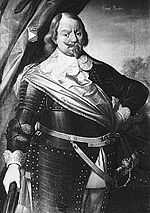Treaty of Bärwalde
The Treaty of Bärwalde (French: Traité de Barwalde; Swedish: Fördraget i Bärwalde; German: Vertrag von Bärwalde) of 23 January 1631 was a treaty concluding an alliance between Sweden and France during the Thirty Years' War,[1] shortly after Sweden had invaded Northern Germany then occupied by Ferdinand II, Holy Roman Emperor's forces.[2] The treaty obliged Sweden to maintain an army of 36,000 troops, and France to fund the Swedish army with an annually 400,000 Reichstalers.[3]
Background
Sweden, who had already intervened in the Battle of Stralsund (1628), started her campaign in the Holy Roman Empire in 1630. The invasion began when Gustavus Adolphus of Sweden had landed in the Duchy of Pomerania[2][4] and concluded an alliance with Bogislaw XIV, Duke of Pomerania, the Treaty of Stettin (1630).[5] Yet, Sweden found no other ally except for the Free imperial city of Magdeburg.[2][6] From the Pomeranian bridgehead, Gustavus Adolphus advanced further south into Brandenburg in early January 1631.[7]
A Franco-Swedish alliance had been prepared since the Truce of Altmark in 1629[8] and agreed on in the Treaty of Västerås on 5 March 1630.[9] On 23 January 1631, French and Swedish negotiators reached an agreement in Brandenburgian Bärwalde (now Mieszkowice) near Pomeranian Greiffenhagen (now Gryfino).[7]
The treaty
The treaty's stated purpose was to protect "common allies, the safety of the North and Baltic Seas, and freedom of trade" as well as the liberation of the "oppressed nobles of the empire".[7] The treaty was scheduled to apply for five years.[1][7] Its core provisions were
- Sweden was to maintain an army of 36,000 troops in Germany:[8] 30,000 infantry, 6,000 cavalry.[3]
- France was to pay an annual 400,000 Reichstalers[1][8] (1,000,000 livres)[3] and an additional 120,000 Reichstalers for 1630.[10]
- France and Sweden were not to conclude peace treaties with third parties without mutual approval.[8]
In addition, the treaty provided religious guarantees, including a guarantee for religious freedom of subdued Catholics.[1][8] Another provision was that France and Sweden respect the neutrality of Bavaria and the Catholic League under certain premises,[1][8] yet these premises were not fulfilled by the time the treaty was concluded.[8]
The treaty was signed by ambassador Hercule de Charnacé, "unofficial agent" of Cardinal Richelieu,[11] for France, and, on behalf of Gustavus Adolphus, Gustav Horn and Johan Banér for Sweden.[12]
While the French subsidies to Sweden agreed on in Bärwalde made up for no more than one fiftieth of the French state budget, they amounted to one quarter of the Swedish one.[13]
Subsequent Franco-Swedish treaties during the Thirty Years' War
The treaty served to fund further advances of Sweden into Germany.[11] Further Franco-Swedish strategical alliances, some including third parties, were concluded in the following years:
- 27 October 1632: Treaty of Toulouse between France, Sweden and the Electorate of Cologne[14]
- 5 September 1633, 26 August 1634, 20 September 1634 and 1 November 1634: Treaties of Frankfurt am Main, Paris, Frankfurt and Paris, respectively, between France, Sweden and the Heilbronn League[15]
- 20 March 1636: Treaty of Wismar between France and Sweden
- 6 March 1638: Treaty of Hamburg between France and Sweden[16]
- 30 June 1641: Treaty of Hamburg between France and Sweden[17]
- 16 April 1643 (amended on 10 July 1643): Treaty of Weissenburg und Dobitschau between France, Sweden and Siebenbürgen
- 30 June 1643: Treaty of Stockholm (1643) between France and Sweden (renewal of Hamburg 1641)[18]
Sources
References
- ↑ 1.0 1.1 1.2 1.3 1.4 Parker (1997), p.121
- ↑ 2.0 2.1 2.2 Parker (1997), p.120
- ↑ 3.0 3.1 3.2 Lutz (2002), p.102
- ↑ Heitz (1995), p.219
- ↑ Heitz (1995), p.220
- ↑ Lorenzen (2006), p.67
- ↑ 7.0 7.1 7.2 7.3 Theologische Realenzyklopädie I (1993), p.175
- ↑ 8.0 8.1 8.2 8.3 8.4 8.5 8.6 Theologische Realenzyklopädie I (1993), p.176
- ↑ Treaty of Västerås 1630-03-05 (in Latin, scan)
- ↑ Huf (2003), p.182
- ↑ 11.0 11.1 Treasure (1995), p.24
- ↑ Porshnev (1995), p.180
- ↑ Porshnev (1995), p.38
- ↑ Treaty of Toulouse 1632-10-27 (in French, edition from Reichsarchiv, vol 7 (1711), pp. 102-103.)
- ↑ Treaty of Frankfurt 1633-09-05 am Main (in Latin, edition from Reichsarchiv, vol 7 (1711), pp. 296 ff.)
Treaty of Paris 1634-11-01 (in French, scan) - ↑ Treaty of Hamburg 1638-03-06 (in French, scan)
- ↑ Treaty of Hamburg 1641-06-30 (in Latin, scan)
- ↑ Treaty of Stockholm 1643-06-30 (in Latin, scan)
Bibliography
- Heitz, Gerhard; Rischer, Henning (1995). Geschichte in Daten. Mecklenburg-Vorpommern (in German). Münster-Berlin: Koehler&Amelang. ISBN 3-7338-0195-4.
- Krause, Gerhard; Balz, Horst Robert (1993). Müller, Gerhard, ed. Theologische Realenzyklopädie I (in German). Walter de Gruyter. ISBN 3-11-013898-0. Retrieved 2009-08-12.
- Hans-Christian Huf - Mit Gottes Segen in die Hölle: Der Dreissigjährige Krieg, Econ 2003
- Lorenzen, Jan N. (2006). Die grossen Schlachten: Mythen, Menschen, Schicksale. Campus Verlag. ISBN 3-593-38122-2. Retrieved 2009-08-09.
- Lutz, Alfred; Kohler (2002). Reformation und Gegenreformation. Volume 10 of Oldenbourg Grundriss der Geschichte (in German) (5 ed.). Oldenbourg Wissenschaftsverlag. ISBN 3-486-49585-2.
- Parker, Geoffrey; Adams, Simon (1997). The Thirty Years' War (2 ed.). Routledge. ISBN 0-415-12883-8. Retrieved 2009-08-12.
- Porshnev, Boris Fedorovich; Dukes, Paul (1995). Muscovy and Sweden in the Thirty Years' War, 1630-1635. Cambridge University Press. ISBN 0-521-45139-6. Retrieved 2009-08-09.
- Treasure, Geoffrey Russell Richards (1995). Mazarin: the crisis of absolutism in France. Routledge. ISBN 0-415-01457-3.
External links
| ||||||||



